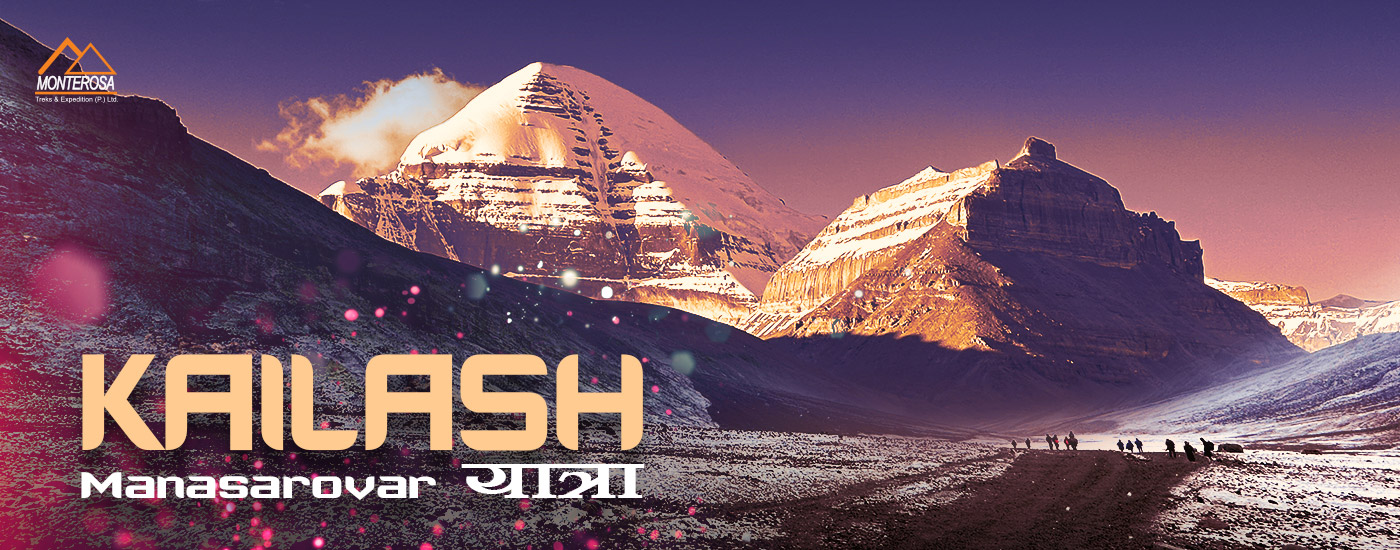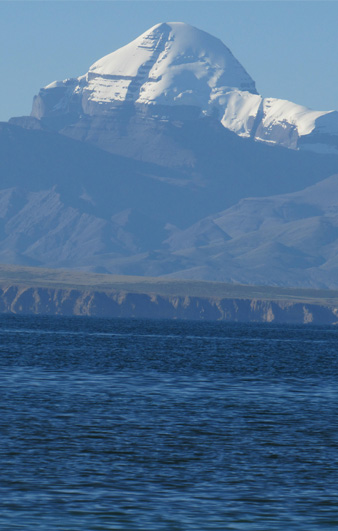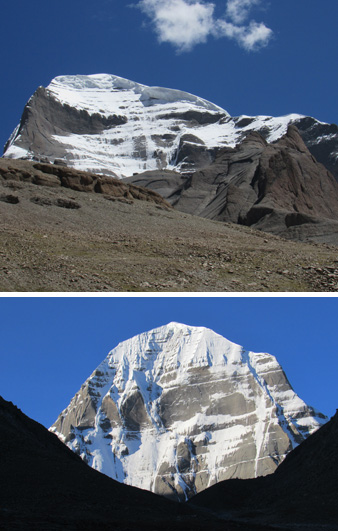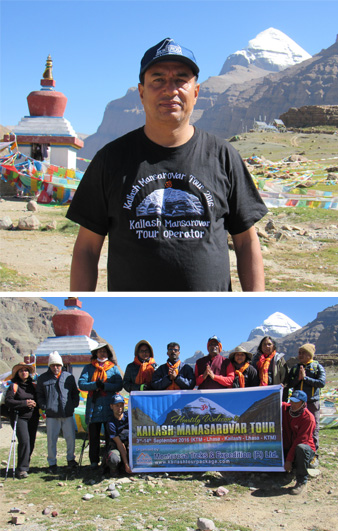
Kailash tour from Lhasa to Lhasa 2025 includes a 14- day journey from Lhasa to Shigatse, Saga, as well as the sacred Mount Kailash Yatra and Lake Mansarovar Yatra, along with the option of custom itineraries from Monterosa Treks and Expedition Pvt. Ltd. The shortest Kailash Manasarovar itinerary is from Lhasa via any city of Mainland China. Take a Kailash tour from Lhasa to Lhasa or a Kathmandu drive. Kailash devotees arriving at Lhasa's international airport will be welcomed and accompanied to Lhasa city, which is 62 kilometers away. Then, you will drive to Shigatse, Saga, Kailash Manasarovar, make 4 days of kora, and then return to Saga, Kerung, and Kathmandu.
Location of the meeting: Upon arrival at Tribhuvan International Airport Kathmandu, our staff will welcome you and take you to your hotel.
 Short Kailash tour Itinerary
Short Kailash tour Itinerary 29 Aug. 2025 Day 01: Arrival Gonggar airport & drive to Lhasa
30 Aug. 2025 Day 02: Sights in Lhasa including Potala Palace
31 Aug. 2025 Day 03: Drive Lhasa to Shigatse 3782m.- Hotel
01 Sept. 2025 Day 04: Drive Shigatse to Saga 4640m. & hotel
02 Sept. 20251 Day 05:Rest or acclimatization in Saga Bazaar
03 Sept. 2025 Day 06: Drive to Manasarovar, drive to Darchen
04 Sept. 2025 Day 07: Drive to Yam Dwar, start walk –Dirapuk
05 Sept. 2025 Day 08: Visit Charan Sparsh north side of Kailash
06 Sept. 2025 Day 09: Trek to Dolma La 5636m. and Zuthulpuk
07 Sept. 2025 Day 10: Trek to Chongdo, drive to Manasarovar
Full moon night in Manasarovar Lake
08 Sept. 2025 Day 11: Drive Manasarovar Lake - Saga Bazaar
09 Sept. 2025 Day 12: Drive to Kerung valley and overnight stay
10 Sept. 2025 Day 13 Drive to Kerung and continue Kathmandu
11 Sept. 2025 Day 14 Transfer to KTM airport for final departure
29 August 2025 Day 01: Upon arrival at Gonggar airport in Tibet, all Yatri and tourists must complete Tibetan immigration formalities and our Tibetan guide will meet you outside the immigration counter. Tibet cannot be entered without a tour guide. Tibetan Khata (white garlands) welcome everyone. At the airport, everyone gets on a minibus or bus and is driven to Lhasa city. It is 60km away and takes about an hour to get there. The amazing sights of naked hills, settlements at the bottom of hills and agricultural land filled with crops enhance our journey. Check-in at the hotel and vegetarian buffet lunch and dinner in the Lhasa town. The day will be spent resting or acclimatizing today. A night's halt in Lhasa is planned.
30 August 2025 Day 02:Located in the heart of Tibet, Lhasa is both its capital and largest city. With wide streets and sky kissing buildings, this city is no less attractive than any developed western country. In addition to this, there is the palace of the Dalai Lama. Besides the Potala Palace, you should also visit the Jokhang temple / monastery at Bharkor Bazaar, the Bharkor Bazaar itself, and the Bharkhor Monastery. The altitude of Lhasa City is 3,600 meters above sea level. Located in the central part of Lhasa city, the Potala Palace stands 150 meters tall. There is also a meditative office building and an administrative office building adjacent to this palace. The Red Palace displays a variety of magical Buddha idols of Buddhist religion, whereas the White Palace contains a Meditation Room, Living Room, and Meeting Room for foreign guests of the Dalai Lama. Transparency is symbolized by the white palace. The Tibetan language refers to Lhasa as a 'Land of Gods and Goddesses'. The city of Lhasa is located in a valley that adjoins two sacred rivers, the Lhasa and Brahmaputra. Buddhists believe that having divine view (Darshan) of Potala Palace and Jokhang Monastery at least once in life can help one attain 'Nirvana', meaning ultimate salvation.
The Potala Palace: It was constructed during the reign of Songtsan Gampo in the 7th century, and was enlarged by the 5th Dalai Lama. Additionally, it becomes the main political and religious palace of the Dalai Lama at this time. The main palace was divided into two sections: the red palace and the white palace. In addition to living quarters, temples, tomb stupas, and monk dormitories, it stands 115,703 meters high. There are countless cultural relics in the palace, such as images, murals, sutras, etc., all of which are extraordinarily valuable. Besides being classified as national treasures, these magnificent Tibetan arts and culture are also listed by the state council as one of the important cultural relics to be protected.
Potala Palace contains gold-plated entombment places for the 5th, 7th, 8th, 9th, 10th, 11th, 12th, and 13th Dalai Lama. In addition to the 13th Dalai Lama's statue, all of these can be seen. The location of the entombment of the 6th Dalai Lama is unknown and mysterious. According to experts, the ashes of the first, second, third, and fourth Dalai Lama were kept at Jokhang Monastery after their funeral rites. Potala Palace has one thousand rooms, of which 27 are open to the public, such as the Bed Room, Living Room, Study Room, Meeting Room, and the Entombment Place of Dalai Lama. He has lived in India since 1959, when he was the 14th Dalai Lama.
31 August 2025 Day 03: In our tourist coach, we begin our journey to Kailash Manasarovar after spending two nights in Lhasa, Lhasa is capital city of Tibet. One hour's drive from Lhasa takes us to the Brahmaputra River, where we pass through its banks to reach Shigatse. In terms of population, the city ranks second after Lhasa. Luxury hotels are available for lodging, and we have arranged a Nepali restaurant for meals. An enormous monastery is located here, popularly known as Tashilimphu Monastery. There are 271 kilometers between Lhasa and Shigatse and it takes 4 -5 hours to drive there.
01 September 2025 Day 04: In the morning, take breakfast and drive to Saga via Lhatse. During the journey today, two high passes were crossed with fine views of the Tibetan countryside. We stop for lunch on the way from Shigatse to Lhatse, which is 160KM by road and takes 3 hours. Toward Saga after lunch, we divide two roads, one leads to New Tingri way and the other goes directly to Saga, which follows the rocky and sandy land of Tibet. The way to Saga Bazaar, nomads chase thousands of Yaks and Sheep grazing grass. The distance between Lhatse and Saga is 300KM, and it takes 5 hours to drive there. Arrive at Saga, check into the hotel, and stay overnight at Saga. Meet the Nepalese staff and have a meal prepared by the Monterosa staff. From Saga and onward, every meal makes our team stronger. Nepali restaurants in Lhasa and Shigatse will serve pure vegetarian food and hotels will serve breakfast.
02 September 2025 Day 05: Today we rest in Saga, due to long drive from Shigatse to Saga. It will be also day hiking up hills as you like.
03 September 2025 Day 06: Saga to Manasarovar & Darchen: After breakfast, we drive to the Manasarovar Lake and Darchen. After passing Dongba and praying, the Kailash group will reach the adjacent point of the Brahmaputra River. As a result of combining two rivers mix, one flowing from the Gangdici River in the Himalayan Range and the other flowing from the Tima Yang Jong River in the Tibetan Himalayan Range, the Brahmaputra flows from Saga, Shigatse, and other places in Tibet into the Gulf of Bengal.
When we stop our van or bus, we serve hot box lunches. We continue our journey after lunch to Hor near the holy Lake Manasarovar, observing beautiful scenery and naked hills. This location offers a fantastic view of the Manasarovar Lake, Mount Gurlamnadata and Kailash Parbat at the same time. In this circumambulation of Manasarovar Lake is 102 kilometers are covered. Walking the circumambulation takes three days for locals, but five days or more for tourists. Normally, we will take the Blue Bus organized by the Nangri Tourism Board to travel around Manasarovar Lake and beyond, but there may be times when the bus is not available there, so we will take the same bus from Lhasa. We will make a half rotation of Manasarovar Lake in approximately two hours or some time more. When circumambulating, we can see Rakshas Lake and Manasarovar Lake simultaneously from top hills before reaching Chiu Monastery. We will reach Chiu Monastery, while rest some time, explore Manasarovar Lake and drive to Darchen another one hour, it is 40KM far. Checking hotel and rest.
Manasarovar Lake
The Manasarovar Lake, also called Brahma's Lake or Mapam Yum Tso Lake, is located at an elevation of 4850 meters above sea level. "Manas" means mind or consciousness, and "Sarovar" means lake. There has been a deep spiritual influence on Hindus and Buddhists as well as a wide range of religious values associated with it. One is believed to be cleansed from sins and from sickness by making a round of the Lake and taking a holy bath in it.
According to ancient Hindu scriptures, this lake is a must visit place for those seeking salvation the highest level of achievement in Hinduism. In the wind, the cascading waves of the Lake look very charming. According to Ramayana, a person who bathes in the pure water of the Manasarovar Lake will reach heaven immediately after death. The Kailash Parbat is located 58 kilometers from Manasarovar Lake to the north. The Brahmaputra River flows eastward from Manasarovar Lake. There are many people who want to visit Kailash Parbat and Manasarovar Lake at least once in their lives.
Hindu tradition holds that Lord Shiva and Goddess Parvati bathe in Manasarovar Lake every day between 2 AM and 4 AM. Stars are also believed to bathe in the lake. There is a myth that pilgrims can watch God during the night at this place. The full moon night is considered to be a good time to see or visit the God Shiva and Goddess Parvati. According to Hindu religious books, all Hindus must visit Manasarovar Lake at least once in their lifetime because it covers a large and pure area. Those who drink the water of Manasarovar and wash away all their sins are believed to be purified
Rakshas Tal (Demon King Ravana Lake) Sarovar
A Hindu traditional story inspired the name of this lake. Carnivorous monsters are believed to hide in the dark waters by Hindus. Rakshas Tal symbolizes dark, destructive power, and people stay away from it because of this belief. This lake has poisonous and fatal water, according to traditional religious beliefs. Consequently, a tunnel was constructed from Manasarovar Lake to replace the poisonous water of this lake. It was sent in this lake with pure water and a golden fish. It was only late that this fish was discovered alive. Since then, people's negative attitudes towards the lake have changed and they have started to go closer to it, but they still do not drink its water. The Rakshas Lake is located west of Manasarovar Lake. Rakshas lake, its altitude is 4,540 meters above sea level. Rakshas Lake is devoid of any birds, unlike Manasarovar Lake,
Mount Kailash
Kailash Parbat, the religious place, is located at 6714 meters above sea level. There is a belief that this is the purest religious region in the world. Prior to the origins of Hinduism, Jainism, and Buddhism, it was supposed to be the center and origin of the world. In the Ramayana and Mahabharata, Kailash Parbat is glorified. A description of Kailash Parbat is essential for the civilization according to ancient Asian stories. The Kailash Parbat is situated in Tibet. There is a lack of satisfactory scientific research in this region.
Kailash is respected equally by different religious groups, including Shaiba, Hindu, Buddhist, Jain and Bon-Po. Kailash is described in Shaiba and Buddhist traditional literature as the center of the world, part of Sumeru. It is revered as Kang Rimpoche by Buddhists. As great natural Mandalas, Kailash and Manasarovar are revered by Buddhists. A Mandala is a symbol of respect and salvation for them. This isolated peak is worshipped by Jain as Aspada. This is the same place where Rishavadev, the founder of this religion and received spiritual salvation. There are various logics to claim this Parbat as sacred. This isolated Parbat is also a source to big rivers like Brahmaputra, Satlaj, Indus and Karnali.
Considering Mount Kailash's perimeter is 53 km, pilgrims should walk 38 km in three days, and if they add the Charan Sparsh (Touch Kailash) tour, it will be a four-day trek with a total perimeter of 61 kilometers. Hindu mythology describes a person who moves around the Kailash Parbat as being free of all sins committed during their lifetime. Nirvana is directly achieved if they move around the Parbat 108 times. A person who moves Nandi once gets a return equivalent to moving around the Kailash 13 times. Its snowy tip is worshipped as the holy river Ganges, and its water is regarded as the form of Lord Shiva. It is more beautiful to observe Mount Kailash from the side of the Dirapuk Monastery. Mount Kailash appears between Mount Manjushree on the right and Mount Bajrapani on the left as seen from Dirapuk. The Ganges River originates at Mount Kailash and meets Lachhu River before mixing with Rakshas Lake. The Kailash Himalayan Ranges from some rivers that flow into Rakshas Lake. The Karnali River flows from the junction of Rakshas Lake. Rakshas Lake's water escapes through the Karnali River, but Manasarovar water is stored in a lake.
04 September 2025 Day 07: Kailash Parikrama/Kora starts here from Darchen to Yam Dwar & Dirapuk on this first day. In the morning, drive to Yam Dwar and walk to Dirapuk (4890 meters/12 kilometers). From Yam Dwar, the Kailash circumambulation [kora] circuit/round/Parikrama begins. Since it's only 6 kilometers away, the blue bus or any bus takes 20 minutes to get there. Yam Dwar is also known as it. Upon getting off the bus at Yam Dwar, all pilgrims make an offering to Lord Shiva. Our next step was to circle the Yam Dwar three time. In Hindu culture, this place is known as Yam Dwar (Gate of Death). A temple shape is built by Yam Dwar, with three bells hanging inside and their names are Barma, Vishnu and Mahadev.
Due to the belief that Yam Dwar's visit brings equal religious gain as Kailash Parbat's, pilgrims with disabilities return to Darchen after paying homage to Kailash Parbat on foot. There are a lot of pilgrims, horses, porters, yaks, and Nepali workers on this path/trail. After walking along the riverside path for three hours, we stopped for lunch. Kailash Parbat and bellow can see elephant can be from here. Dirapuk can be reached after a two-hour walk. On the banks of the Lachhu River lies the Dirapuk Monastery. The Monastery itself gives the name to this place. This monastery is located at a height of 4900 meters above sea level. The view from here gives Kailash the appearance of being in heaven.
On a daily basis, hundreds of pilgrims arrive by horseback or on foot at Dirapuk from Yam Dwar. For the 4 days, some Yatri prefer to take a pony and a local porter. If you wish to take a pony and porter, please inform the Tibetan guide in advance. To walk continuously today will take me between five and six hours. Yaks will carry all of our equipment and goods, as well as your bags. Dirapuk has mud houses/guesthouses where you can stay overnight and see the north face of Mt Kailash.
05 September 2025 Day 08: Pilgrims walk 4 hours (4km) from Dirapuk to Mount Kailash, also known as Charan Sparsh, after breakfast. They feel blessed by Lord Shiva when they touch the base of Kailash Mountain. It is customary for pilgrims to perform Pooja in order to receive Shiva's blessings.
It is the word "Charan" that means "feet" and the word "Sparsh" that means "to touch". "to touch one's feet" means to touch one's feet together Touching. the feet of Kailash Parbat have been a tradition since ancient times. There is scientific basis for "Charan Sparsh.". In traditional beliefs, the human body releases vibrations that touch the feet, facilitating the flow of energy, blessings, happiness and success. The exchange of energy gives one vigor, self-confidence and contentment. There is a glow emanating from within. As a result of "Charan Sparsh", blessings are like invisible amour. They provide strength and motivation.
06 September 2025 Day 09:It is a very crucial day for us, as we have to cross Dolma La or Dorma La Pass, which is 5636 meters above sea level. The weather in Dolma La Pass is unpredictable with snowstorms possible at times. Our journey should begin as early as possible in the morning. We pass Ganesh Kund and Gauri Kund lakes on the way. To reach Zuthulpuk monastery, descend Shapje Datok pass. A mud house is a great place to stay overnight in Zuthulpuk.
GANESH KUND (SAROVAR)
There is a holy Ganesh Kund on the right-hand side of the walking trail about 45 minutes before reaching the Dolma La Pass 5636m., (Kailash circuit). Walking trails are 15 minutes away. Kund's shape resembles that of Ganesh's bathing place.
THE LEGEND OF GAURI KUND
Hindu mythology mentions Gauri Kund or Parvati Kund in the Shiva Purana legend, which is Sanatana Dharma. As per the Puran, Gauri Sarovar purifies the mind, body and speech of Kailash Yatri by purifying the mind and the body. Most Yatri of Kailash Manasarovar tours include their tour program. As part of the holy bath to Goddess Parvati Mata, this Gauri Kund is where Gauri Mata acquired her beloved son Ganesh. She molded the image of her son Ganesh from cleaning agents frothing on her body and revived it.
To prevent unknown from entering her holy deep, she placed Ganesh along the path. Meanwhile, Lord Shiva arrived at Mount Kailash, but Ganesh ji did not recognize him, so he became furious and cut off the child's head. Mata Parvati was devastated when she saw it and requested that Lord Shiva return the child to life and she received her son back. Kailash Yatri is not the only one fascinated by this real story.
THE MEANING OR SIGNIFICANCE TO VISIT GAURI KUND.
Kailash Yatri visits this holy Kund during their Parikrama or Kora to purify their minds, bodies and speech by splashing the Jaal on their heads. To ensure peace in the heavens, they offer their ancestors TARPANA and Jaal (holy water). Their homes are often filled with holy water brought from the Kund.
WHERE IS THE GAURI KUND LOCATED?
At 5608m. above sea level, the turquoise-colored GAURI KUND is located after crossing steep descents of Dolma La pass, the highest pass during Kailash Manasarovar Yatra tour. There is no walking trail yet and one must walk on massif rock.
07 September 2025 Day 10: Take breakfast and walk to Chongdo, then drive to Darchen and Manasarovar Lake. Using holy water from Manasarovar, our staff erected a big tent for bathing inside the tent. The pilgrims offer Tarpon / holy water offering, flowers, money and splash water among themselves after bathing. As Monterosa Treks and Expeditions prepare for worship and Rudrabhishek, Hawan, Aarati, and chanting Shostibhacahn by Nepal Braman Pandit and begins rituals. All pilgrims can do prey for Lord Shiva and reciting the names of their ancestral gods, and performing Hawan (offering grains mixed with butter to the fire) in the name of gods, in order to cleanse themselves from any kind of sin that they might have committed.
Located at an elevation of 4850 meters above sea level, Manasarovar Lake is also known as Brahma's Lake or Mapam Yum Tso Lake. 'Manas' means mind or consciousness, and 'Sarovar' means lake. Hindus and Buddhists have cherished it for its deep spiritual influence and wide religious values. Taking a holy bath in the Lake is believed to cleanse the soul from sins and the body from illness.This Lake is mentioned in ancient Hindu scriptures as a place to visit if one wishes to achieve salvation, the highest achievement in Hinduism. There's something very charming about the cascading waves of the Lake in the wind. Full moon night in Manasarovar
08 September 2025 Day 11: Drive to Manasarovar and complete half of the lake's rotation, continue to Praying, Dongba, and ultimately Saga bazaar for an overnight stay.
09 September 2025 Day 12: It takes 4 to 5 hours' drive from Saga to Kerung valley. In the Kerung valley, you will spend the night.
10 September 2025 Day 13: drive to friendship bridge, approximately 50 km from Kerung valley. the Nepal Tibet boarder. Tibetan customs and immigration formalities, as well as Nepalese customs and immigration formalities. After crossing boarder, you will be driving to Kathmandu with 4 Yatri in a Jeep and takes 6 to 7 hours. It will be reaching Kathmandu late afternoon around 4 to 6 O'clock time. It is estimate time.
11 September 2025 Day 14:Transfer hotel to Kathmandu Tribhuvan International Airport for final departure
Note: If anybody required Helicopter from Shybrubesi to Kathmandu and it should be needing 5 persons and per person will be USD 300 on way
 ur
urPer Person USD 3000 (Double / Twin / triple room sharing basis)
Per Person USD 3500 (Single Room Basis)
(Full meal Vegetarian Breakfast, Lunch, dinner) as fallow itinerary)
Extra cost if required for Kailash Circuit
Horse ride during the Parikrama 1 horse for 4 days USD 515
(Directly payable to the Tibetan guide)
Porter for carrying small bag for 4 days round Kailash USD 220
(Subject to change price if incase increase or decrease for pony & porter cost, no sharing each other)
Hotel in Kathmandu
5 Star Deluxe hotel Radisson or Similar (Single / Double / Twin / Triple bed room)
Hotel in Tibet Lhasa & en route
Lhasa Tibet: 5 - Star Shangri La or Similar - Full Meals (Single / Double / Triple bed room)
Shigatse: 5 - star Gesar Hotel (New Building) Full Meals (Single / Double / Triple bed room)
Saga: 4 Star North Holiday hotel or Similar (Single / Double / Triple bed room)
Manasarovar Lake: Guest house or mud houses (Doremitary more than 6 beds room)
Darchen: 4 - star Hotel Kailash Himalayan (Single / Double bed room)
Dirapuk: Normal guesthouse (Parikrama first day) (Doremitary more than 6 beds room)
Zuthulpuk: Normal guesthouse (Parikrama 2 day) (Doremitary more than 6 beds room)
Kerung: 3 Star hotel Post Business or similar (Single / Double / Triple bed room)
(Full meal Vegetarian Breakfast, Lunch, dinner) as fallow itinerary)
Note:4 nights in 3 places like Manasarovar Lake, first day of circuit - Dirapuk and second day of circuit - Zuthulpuk will be dromedary bed room and very basic toiletry available. If cannot adjust this basic service as well as common toilet facilities, please don't travel it.
 1-night hotel in Kathmandu (double-bed sharing basis) full
1-night hotel in Kathmandu (double-bed sharing basis) full Oxygen is less at higher altitudes. The inclement weather and high altitude induce certain illness generally not encountered in the plains. Headache, nausea, lassitude, lethargy, breathlessness, general uneasiness [malaise], high irritability, light loss of balance, disorientation, incoherence and insomnia are a few. It is common to all irrespective of the age, sex and physical fitness. Gradual acclimatization is the best answer. Tranquilizers, sleeping dose and strong anti-biotic must be avoided. The best idea is to deliberately slow down all the activities and have the following suggestions in mind:
Om Namo Shivaya ! Jaya Bhole Nath !! Har Har Mahadev!!!
What our client's says about Kailash yatra and tour operator